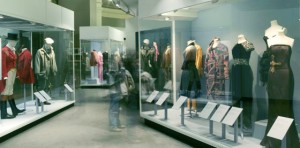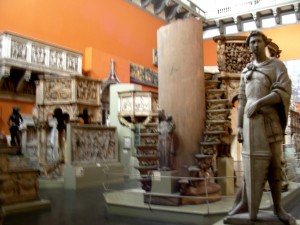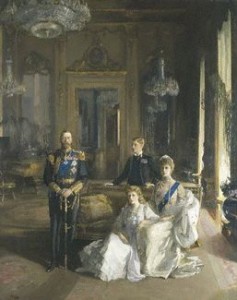
“Eve” by Thomas Brock, 1899
Seeing the Victoria and Albert Museum is a must. And you most definitely should enter the museum via the Tube entrance. Prior to my visit, I naïvely believed the Victoria and Albert Museum would display art from Queen Victoria’s reign to illustrate the period—I found myself mistaken. Upon entering V&A from the underground tunnel, I immediately stepped foot into a series of small, dark rooms off to the right. The rooms modestly displayed furniture and tapestries from Europe dating from the seventeenth to nineteenth century. I then wandered into the main museum hallway above ground and explored the diverse assortment of sculptures extending down a long hallway. Taken aback, I quickly realized the V&A actually displayed a much broader range of art. By the end of my visit, I found that was a huge understatement. The Victoria and Albert Museum is enormous and houses a collection of almost every type of visual art.

Fashion Exhibit
The museum map became somewhat useless and rather bothersome as I wandered through the labyrinth of art. Branching off of the main sculpture room—which included work from a favorite sculptor of mine, Rodin—were displays of art from China, the Islamic Middle East, Japan, Korea, South Asia, and South-East Asia. Another room I thoroughly enjoyed was a room presenting fashions from Italy, the United States, Japan, England, and France. The clothing dated from the eighteenth century through today. I only explored parts of the first floor and I still had five more levels!

Plaster-casted Sculpture Exhibit (personal photo)
Throughout the remainder of my museum tour, I discovered collections of photography, mini architecture models, prints, drawings, paintings, tapestries, sacred silver and gold, and stained glass. There were also two massive rooms of plaster-casted architecture and sculptures dating from the eighteenth century, when plaster-casting famous works was popular for museum displays. Numerous rooms displayed eclectic exhibits of Medieval and Renaissance European art from the fourth to seventeenth century. When I finally stumbled into a dark hidden room of priceless jewelry dating back from 1500 BC, I was irrevocably astounded. I was lost in the Victoria and Albert museum but when discovering all these sorts of extraordinary pieces of art, who didn’t want to be?

Stained-glass Exhibit (personal photo)
On the whole, the museum’s collection was incredible (if that’s not obvious already). I was completely taken aback by the wide array of art displayed, as well as the priceless items included—countless pieces of silver and jewelry, as well as Leonardo da Vinci’s notebooks and Raphael’s paintings (coming soon). However, the organization of the museum is a contentious topic. The pieces of art come from all over the globe and date back to 1500 BC. Also, obviously, the museum includes almost every type of art. To mitigate this challenge of organizing the art, the museum’s ironically set-up like a maze. The different rooms intertwine and lead you through every floor, and each room is included in the art display. For example, doorways to Renaissance Europe boast beautiful marble columns, tiled floors mimic mosaics on display, monolithic architectural structures make Italian plaster-casted sculptures seem authentic, and aged brick walls and cobblestone floors bring life to the medieval ironwork.

Large-scale Medieval and Renaissance Architecture (personal photo)
From what I could gather, it seems as though the Victoria and Albert Museum is a massive collection of treasures donated by organizations and wealthy individuals. For one, the galleries of donated art pieces ostentatiously display the donor’s name on the wall. Overall, the V&A Museum is a display of wealth—both of England’s monetary wealth and of its wealth of knowledge in the arts. The museum has put on display priceless pieces of art from around the world. The English are subtly, but really quite clearly, boasting. Typical.

One Exhibit’s Entranceway (personal photo)
Tags: 2010 Mary · Museums
September 5th, 2010 · 3 Comments
I have been juggling with what to say in this post. I have been sifting through my likes and dislikes concerning the National Portrait Gallery and have come to a couple conclusions: Their collection is awesome, but it is incomplete and the lay out of the rooms was misleading and without enough direction.
Just as everyone has recognized, the collection consisted primarily of portraits of white people. Looking back, I really don’t remember seeing any portraits that focused on any other person of a different race. Because of this, the collection failed to do what I had expected it to do. If I had no knowledge of British history, than I would not have been able to draw an accurate account form this collection. I expected to walk through the rooms and see, as the portraits became more and more recent, examples of the diversification of England, of its people, and of its actions. Colonialism and imperialism representation was so underwhelming. But then I start to question what the point of the gallery is… What is the point? Without recognizing the importance of an array of different people, from all races, on England and its history as an empire, or even contemporary, there really is no point. Like I said before, I expected to get a glance at British history from walking through this collection, but it was so incomplete that it lost much of its meaning.
My second point, which is not about the collection itself, but how it was laid out, is also related to how I feel the gallery did a poor job representing the history of the nation. I would have like arrows. Seriously. I would have like to have been told where to start and which rooms to go into next. I understand that by the end the rooms became thematic, but I still believe they should have been placed one after another. Only dabbling in chronological order is confusing.

(Lavery, John. The Royal Family at Buckingham Palace. 1913. The National Portrait Gallery, London.)
I chose the portrait above in particular to look at because it was unusual and stood out from all the others. It was the portrait of the royal family in 1913 by Sir John Lavery. Its immensity was the first thing that caught my eye. It was of Prince Edward, King George V, Queen Mary and Princess Mary. The two women were sitting and the men were standing behind them. However, they did not take up the whole canvas. Most of the portrait was actually of the room. There were mirrors, chandeliers, couches, and tables. I began to focus more on the surroundings than the people in the painting. There was a window with light shinning through, casting shadows of the royal family. The corners of the room were dark. There was an open door behind the family, leading into another room. The dimensions of this portrait were fascinating and I spent a lot of time creeping through all its levels with my eyes. Another thing I noticed was the the whole family was looking forward except for Prince Edward, who was looking at his father. Again, Lavery is playing with dimensions, but this example is dealing with time. This glance that Edward is giving King George V takes the portrait out of static. Its not just right here, right now, but it is also about what is to come. I thought that was awesome.
Tags: 2010 David · Uncategorized
September 5th, 2010 · 3 Comments
When people at home learned that I was going to be studying in Europe all year, many of them said something along the lines of, “Oh, watch out, they hate Americans.” The incredible sense of encouragment and support that I took from this statement aside, I was a bit worried and started reading Kate Fox like it was the Bible of Englishness. Now that we’ve been here for a bit, however, I’ve noticed some variations in English behavior and have witnessed some interesting responses to my American-ness.
It’s true that hardly anyone talks on the Tube and people rush by each other in the streets seemingly without giving notice of their fellow travelers. Kate Fox’s rules seem to be holding true. At the Hard Rock Cafe, however, all of those rules were thrown to the wind. We’ll start in the bar—the bartenders, two young men, were clearly showing off and attracting attention to themselves and their drink-pouring abilities. At one point, one of the waiters even jumped on a bartender’s back. They were *gasp* boasting. Granted, they had already had a few drinks themselves by this point, and one of them assured me that he was going to drink more later when I tried out the “And one for yourself?” rule. The rule-breaking then continued with our server, who had no problem at all pulling up a chair to our table, poking gentle fun at us, putting her arm around someone’s shoulders, etc… She was much more dynamic and got much more personal than I expected. I don’t know if Fox’s rules are more relaxed at Hard Rock because it’s such a tourist attraction, or if it’s because the atmosphere just attracts more outgoing people. I don’t believe that the fact that we were a large group of young Americans played a part in this interaction, though.
Most people whom I’ve interacted with simply nod and smile a bit when they hear my American accent, as if to say, “American–that’s why it’s taking her so long to count the proper change.” Two instances gave me a lot to think about, however. I was at a sandwich shop one night, and the cashier asked me where I was from. We started talking a bit, and it turns out that he not only knows where Pennsylvania is, but has the dream of traveling from the East Coast to the West Coast someday. He’s been working in England for seven years in order to save money to get to America. He’s originally from Brazil, but has lived and worked in most countries in Western Europe, making his way westward. He was so positive about the States, and he gave me a pound off of my sandwich for talking to him. I’m thinking that he was just excited to find someone who would talk to him about something other than the weather. I saw this need to reach out to a friendly stranger in the British Museum, as well. I was standing in front of the Rosetta Stone, listening to the podcast, when someone tapped me on the shoulder and asked where I was from. Completely un-English behavior! Woah. I said, “the States,” because most people who have asked me that have been British, but this guy looked at me like I was an idiot. “Which state?” he asked. He explained that he’s from Missouri and is here on his quarter-life crisis with his father, and was in need of something to do. His father’s contribution to the conversation consisted of, “New England! Ah!” It was a very odd interaction, and, being pretty shy, I was taken aback. But again, I think that they were just really excited to talk to someone who would have a conversation with them, and bonus! spoke in an American accent.
I’m interested to see if this kind of interaction continues as I’m here for longer, and I especially want to see if they continue in Norwich. I feel that they’re possible in London because there are so many tourists and a larger population of non-native Brits.
Tags: 2010 Holly







